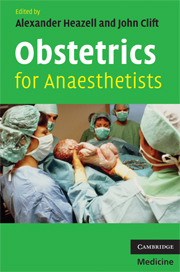Book contents
- Frontmatter
- Contents
- List of contributors
- Foreword
- Preface
- Acknowledgements
- List of abbreviations
- 1 Maternal physiology and obstetrics
- 2 Antenatal care
- 3 Induction of labour
- 4 Normal labour
- 5 Abnormal labour
- 6 Fetal monitoring
- 7 Pre-eclampsia and hypertensive disorders of pregnancy
- 8 Operative obstetrics
- 9 Obstetric haemorrhage
- 10 Thromboembolic disorders of pregnancy
- 11 Infection
- 12 Life support in obstetrics
- 13 Drugs in obstetrics
- 14 Confidential enquiries into fetal, neonatal and maternal death
- Appendix 1 Adult Advanced Life Support Algorithm
- Appendix 2 The Management of Postpartum Haemorrhage Algorithm
- Appendix 3 Emergency Management of Eclamptic Fit Algorithm
- Index
Preface
Published online by Cambridge University Press: 21 August 2009
- Frontmatter
- Contents
- List of contributors
- Foreword
- Preface
- Acknowledgements
- List of abbreviations
- 1 Maternal physiology and obstetrics
- 2 Antenatal care
- 3 Induction of labour
- 4 Normal labour
- 5 Abnormal labour
- 6 Fetal monitoring
- 7 Pre-eclampsia and hypertensive disorders of pregnancy
- 8 Operative obstetrics
- 9 Obstetric haemorrhage
- 10 Thromboembolic disorders of pregnancy
- 11 Infection
- 12 Life support in obstetrics
- 13 Drugs in obstetrics
- 14 Confidential enquiries into fetal, neonatal and maternal death
- Appendix 1 Adult Advanced Life Support Algorithm
- Appendix 2 The Management of Postpartum Haemorrhage Algorithm
- Appendix 3 Emergency Management of Eclamptic Fit Algorithm
- Index
Summary
Anaesthetists on labour ward form an important part of a multi disciplinary team that includes obstetricians, midwives, paediatricians and theatre staff. This role is becoming ever important as anaesthetists now participate in the management of over 50% of patients in a typical unit. As well as traditional roles of providing analgesia and anaesthesia, anaesthetists are also involved in the acute management of conditions related to pregnancy, such as pre-eclampsia and major obstetric haemorrhage, and also coordinating and planning the care of patients with coexisting medical diseases.
Good communication on labour ward is vital to ensure clear, early decision making, and to be able to communicate the anaesthetist must be able to understand the basics of obstetrics. In common with most medical specialities obstetrics has terms and conditions unique to the speciality. In addition, there are a specialised set of procedures, many of which have important differences compared to normal medical and surgical practice. A lack of understanding of obstetric terminology and the significance of obstetricians' observations may lead to inefficient functioning of the team. Most anaesthetists, including trainees and consultants, have had no formal obstetric training since they were medical students.
The aim of this book is to provide anaesthetists with a basic knowledge of obstetrics and, more importantly, the implications this will have on their anaesthetic practice. This book is intended to complement, rather than replace, standard texts on obstetric anaesthesia and will hopefully provide a greater insight into the obstetric mysteries of labour ward!
We are keen to receive comments or suggestions about the book.
- Type
- Chapter
- Information
- Obstetrics for Anaesthetists , pp. xiiiPublisher: Cambridge University PressPrint publication year: 2008

